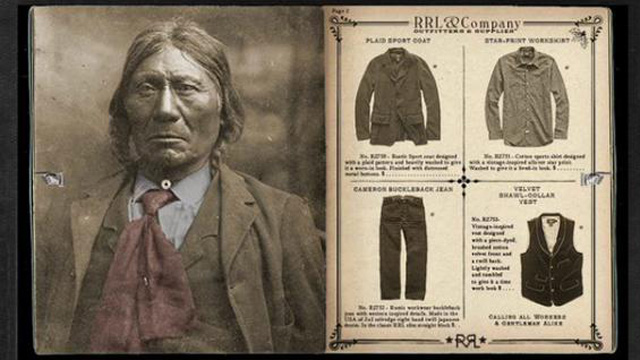Now, Lauren has found a new way to appropriate Native culture, while inflicting real psychic harm on Native people at the same time; reinscribe the historical trauma of a 19th century-originated genocidal policy of forced cultural assimilation and massive dispossession of tribal lands upon them by using the frozen images of their dead relatives in faux-assimilationist pose.
For his 2014 holiday ad campaign Lauren decided to show off his new line of clothing by using old-styled photos of stoically posed, fashionably dressed and long-since-deceased Native American men. What a great business model. Use dead Indians as fashion models so you don’t have to pay for your fashion models. They are just there for the taking.
The problem, as Lauren, discovered (his company quickly issued an apology and withdrew the pictures from its website after calls for a boycott by Native activists) was that his use of these images invoked a familiar language that he assumed most Americans would understand immediately when it came to using these ghoulish if not garish pictures of dressed-up dead Indians. He just didn’t expect that Native Americans would recognize the racist language of Indian stereotyping and imagery for what it is, be highly offended by his ad campaign and launch a boycott in response.
For Native American peoples, the pictures in the Lauren ad campaign serve to commemorate, in a most disrespectful and dehumanizing fashion, a brutal period in United States history when our government forced (sometimes violently) the assimilation and dispossession of Native Americans.
The idea of Native Americans as perpetual savages, frozen in time, nostalgically remembered and freely available for cultural appropriation is a familiar and deeply embedded part of our American racial imagination. This image of the Indian as savage can be found in Thomas Jefferson’s Declaration of Independence, the presidential speeches of George Washington, binding Supreme Court legal precedents, dimestore novels, comic books, Hollywood westerns and throughout American high fashion, culture and art. It can even be found emblazoned on the helmets of a not-to-be-named professional football team that plays its games in Washington, DC, the nation’s capital.
Hopefully Lauren has now learned something new and important that he apparently didn’t know before. It’s simply no longer fashionable to use the racist language of savagery to describe, imagine and stereotype Native American peoples as different and alien from the rest of us here in America. It’s a lesson that not only Lauren, but also many more American businesses need to learn, if not just for the sake of their business models and bottom line.
The views expressed in this post are the author’s alone, and presented here to offer a variety of perspectives to our readers.



